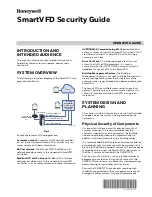
- Lepton
7
x1 - Lepton
7
x4 - Technical Information Manual
13
Reset Pin
The R7101C Lepton
7
x1/R7104C Lepton
7
x4 may be reset by a logic low voltage on the NRST pin (pin 14).
Usage of this pin is recommended in all designs. It may be used to reset the part if an unexpected
operating state is entered. The R7101C Lepton
7
x1/R7104C Lepton
7
x4 does have an internal watchdog
circuit that will reset it if abnormal operation occurs, but the NRST pin provides a further level of reliability.
The NRST pin is pulled high (3.3 V) by an internal 51,1
kΩ nominal resistor. To re
set the part, drive the pin
strong low for at least the minimum reset pulse width as specified in §
(approximately 25 μs). This p
in may be driven active low to reset the part,
but should not be driven strong high. Driving the pin strong high prevents the R7101C Lepton
7
x1/R7104C
Lepton
7
x4 from resetting itself in case user requested software reset. This pin should be driven using an
“open drain drives low” drive mode, which creates either a strong low voltage or a floating voltage output.
GPIO Pins
The R7101C Lepton
7
x1/R7104C Lepton
7
x4 GPIOs can be controlled using the easy2read
©
interface. Their
drive mode, direction, and state are all controllable via easy2read
©
. There are two directions: input and
output. In both input and output directions, there are three possible pin states: high, low, and float. For
more details on using easy2read
©
to control the GPIOs, see the easy2read
©
protocol documentation.
In the output direction, the GPIOs are driven strong high and low with a source and sink current of 8 mA,
and in float mode the pin is not driven either high or low, lea
ving the pin floating, also known as “high
impedance” or “high
-
Z”. T
he pins are driven to 3.3 V nominally. If the load on a pin draws more than the 8
mA sink and source current, the pin is not guaranteed to meet the VOH and VOL specs listed in the §
Input and Output Specifications
Warning
: Excessive current sunk or sourced on the GPIO pins can also cause electrical damage
to the device.
In the input direction, the high and low states apply a pull-up or pull-down resistor, and in float mode the
pin is not pulled either high or lo
w, leaving the pin floating, also known as “high impedance” or “high
-
Z”.
The pull-up and pull-down resistors are about 35
kΩ nominal.
See the §
paragraph page 17 for more specific ratings. The inputs logic levels are proportional to 3.3 V.
Specific VIH and VIL specs may be found in the §
Device Input and Output Specifications
Warning
: Voltages outside of the maximum IO operating voltage range of -0.3 to 4.0 V should
not be applied to the pins, no matter their configuration. This can cause permanent damage to
the device.














































